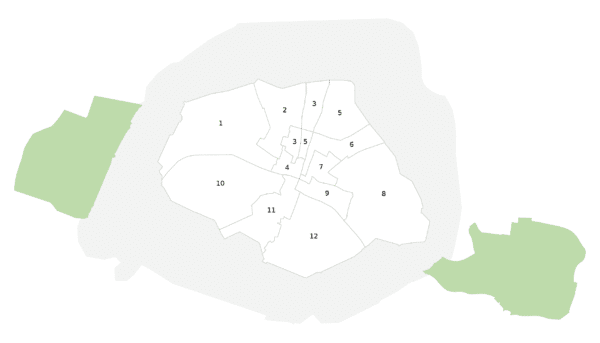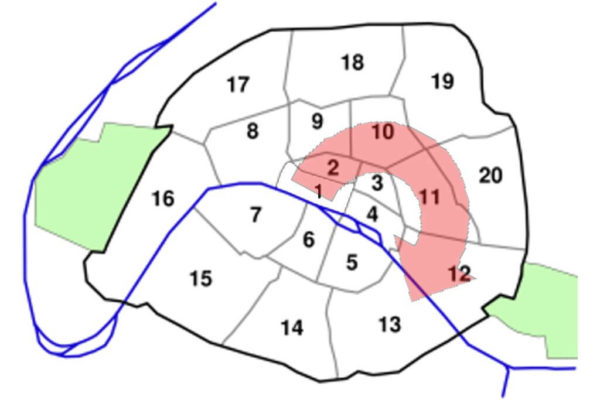
Navigating the neighborhoods of Paris can be quite confusing for those who are not from here. Between understanding the arrondissements, districts, and neighborhoods and finding your way around the spiral that derives from the history of Paris, one can easily become turned around. Whether visiting Paris, looking to buy in Paris, or trying to find your bearings as a new resident, here is some helpful information, tips and tricks to find your way around.
Paris Arrondissements – Districts – Neighborhoods

Let’s start with the Paris Arrondissements. The Arrondissements of Paris are pure administrative divisions with 20 Arrondissements (or districts). The number of the arrondissement is indicated by the last two digits in most Paris postal codes (75001 up to 75020). In each District of Paris, there is a town hall (Mairie) and a mayor (Maire), as well as elected officials, a council, and they each have their own Coat of Arms. All 20 Districts of Paris are still subject to the overall policy of the City and the Mayor of Paris, the Socialist Anne Hidalgo, who resides at Hotel De Ville, the town hall over all of Paris.
Paris Districts and Arrondissements are the same thing, they are just synonyms used in Paris. But, I do warn you, to call an Arrondissement a District in Paris is a dead give away that you are not from around here. The Arrondissements of Paris are not to be confused with the Neighborhoods of Paris (Quartiers). Paris Neighborhoods like Belleville, Saint-Germain-des-Près, and many more, are historic divisions while the Arrondissements of Paris exist only since the 18th century. One Arrondissement can include several Paris Neighborhoods within its boundaries.
The History and naming of the arrondissements
After the French Revolution, Paris (and France as a whole) underwent a “rational” naming change from traditional names to numbered municipalities/départements. The Paris arrondissements were first created in 1795. At this time, the city was much smaller (for example, Montmartre wasn’t even considered to be part of Paris!) and so there were only 12 original districts of the French capital. All of this changed in 1860 (following the overhaul of the city by Haussmann). It was also at this point that towns which had previously been autonomous were absorbed into the fabric of Paris itself. New arrondissements were created and so thus the 20 arrondissements of Paris were born.

Map showing the twelve original arrondissements as of 1795. The surrounding grey area shows the size of Paris after expansion in 1860.
The Arrondissements are often abbreviated (as you will see on every street sign), for example, the fourth arrondissement as “4th” or IVe (the e is for fourth in French – “quatrieme”
). The very center of Paris is the 1er (first) arrondissement, and then the numbers form a clockwise spiral moving toward the outer part of the city finishing in the 20th Arrondissement in the east.. So, in general, a smaller number is closer to the historic center of Paris.
Orientation to Paris’ Neighborhoods
As discussed, the Neighborhoods and Arrondissements are separate but also often overlap. The Neighborhoods were named long before the Arrondissements were invented. They have undefined boundaries and represent cultural clusters making up different parts of the city. The first four Arrondissements (which contain several different neighborhoods) are considered Central Paris (Paris Central). Below you will find some, but not nearly all the neighborhoods of Paris.

Overview of the 20 Arr and some of the neighborhoods of Paris:
- Paris 1 – Louvre – Les Halles – Palais Royal
- Paris 2 – Bourse – Montorgueil – Sentier
- Paris 3 – Temple – Arts et Métiers
- Paris 4 – Hôtel de Ville – Le Marais –
- Paris 5 – The Latin Quarter – Sorbonne – Luxembourg
- Paris 6 – Saint-Germain-des-Prés
- Paris 7 – The Eiffel Tower District – Invalid
- Paris 8 – Elysée – Concorde – Madeleine
- Paris 9 – Opéra – Saint Georges
- Paris 10 – Canal Saint-Martin
- Paris 11 – République
- Paris 12 – Reuilly – Nation
- Paris 13 – Butte-aux-Cailles
- Paris 14 – Montparnasse
- Paris 15 – Vaugirard – Grenelle
- Paris 16 – Chaillot – Auteuil – Passy
- Paris 17 – Batignolles – Monceau
- Paris 18 – Montmartre
- Paris 19 – Buttes-Chaumont – La Villette
- Paris 20 – Belleville
These tips and tricks will help you find your way around and before you know it, you will be using both the names of the Quatiers and the Arrondissements.
Content found on articles:
Contact Paris Property Group to learn more about buying or selling property in Paris.


Social Cookies
Social Cookies are used to enable you to share pages and content you find interesting throughout the website through third-party social networking or other websites (including, potentially for advertising purposes related to social networking).